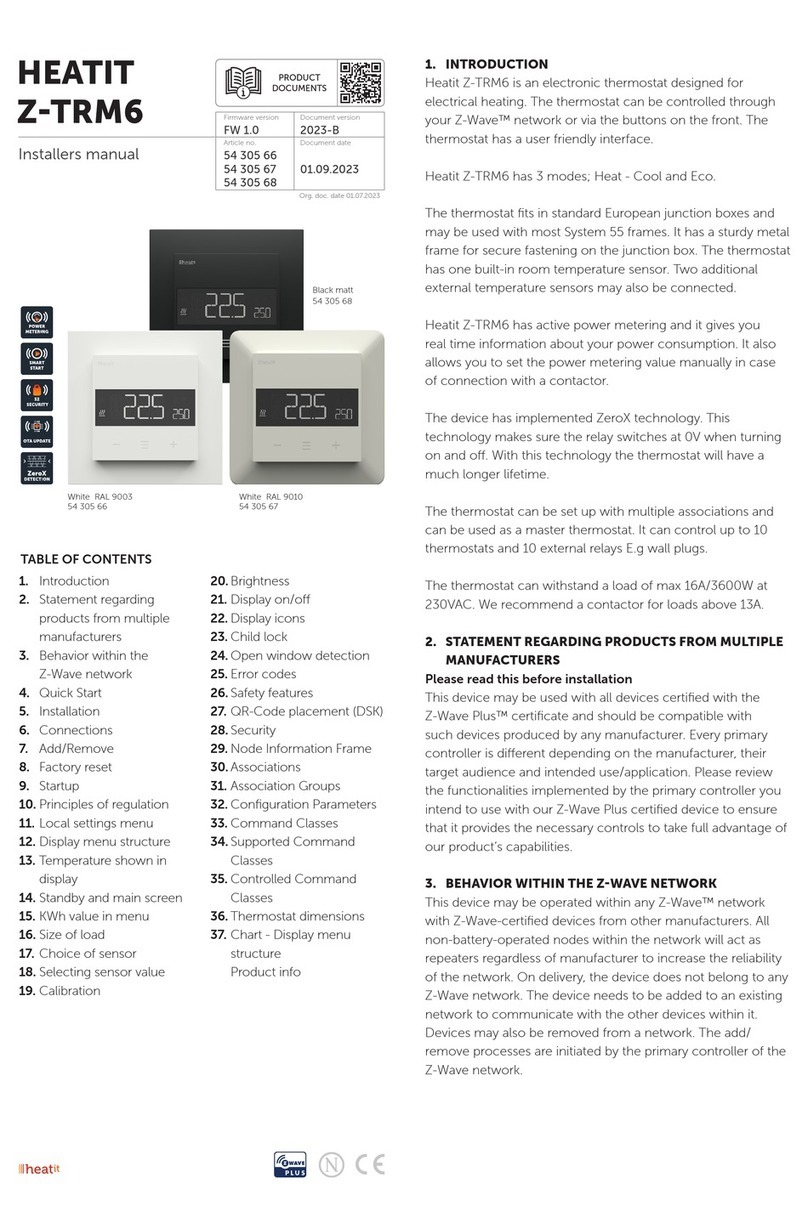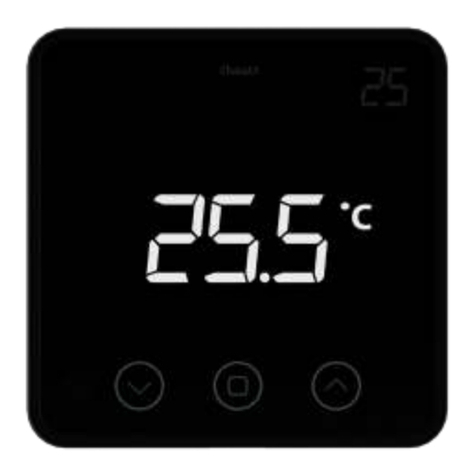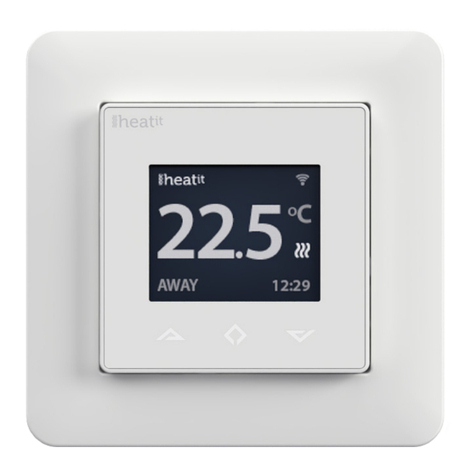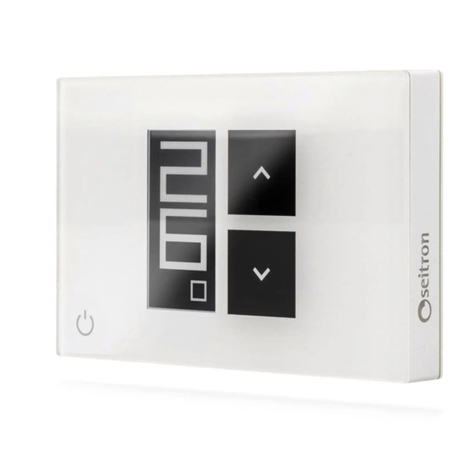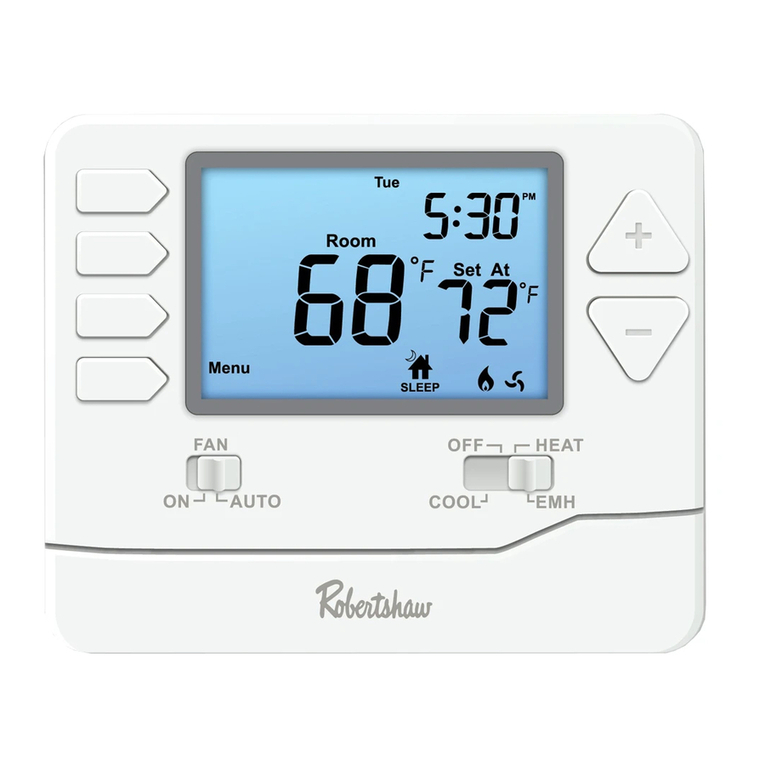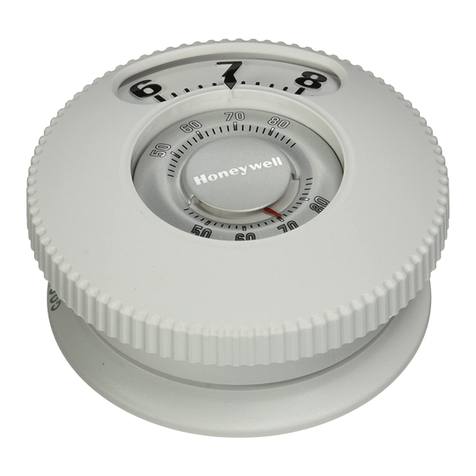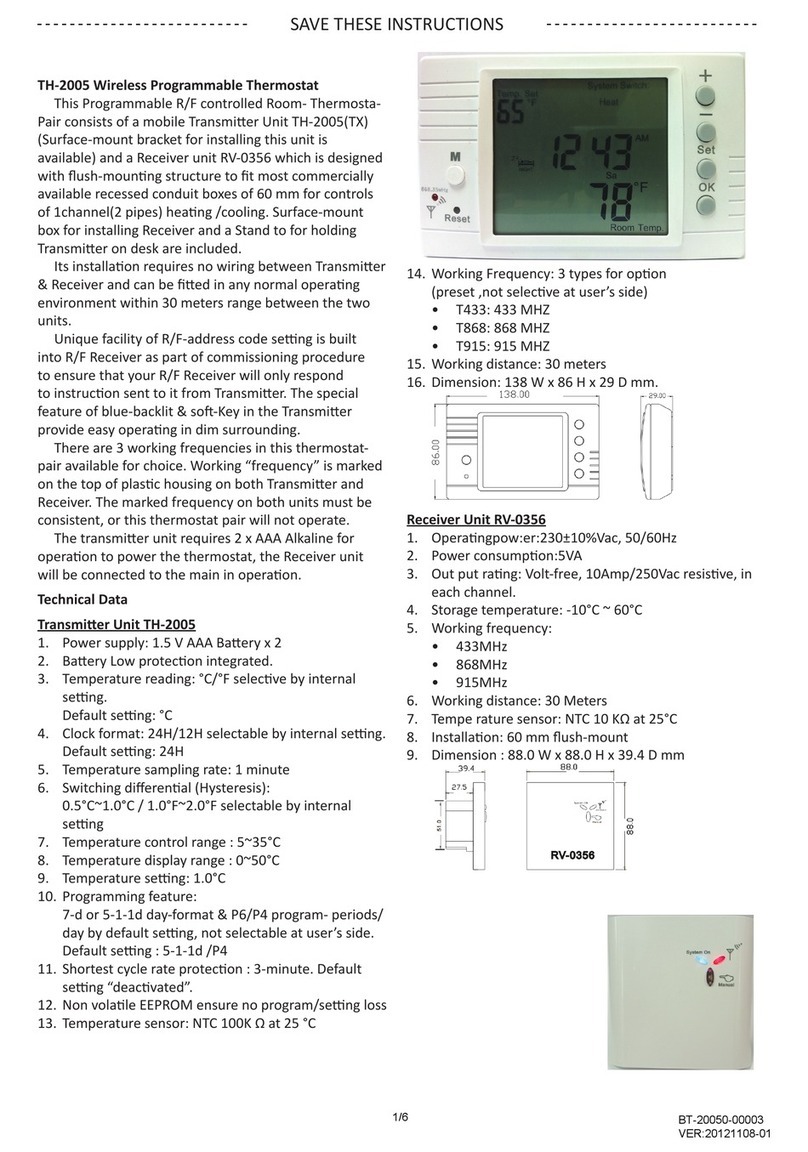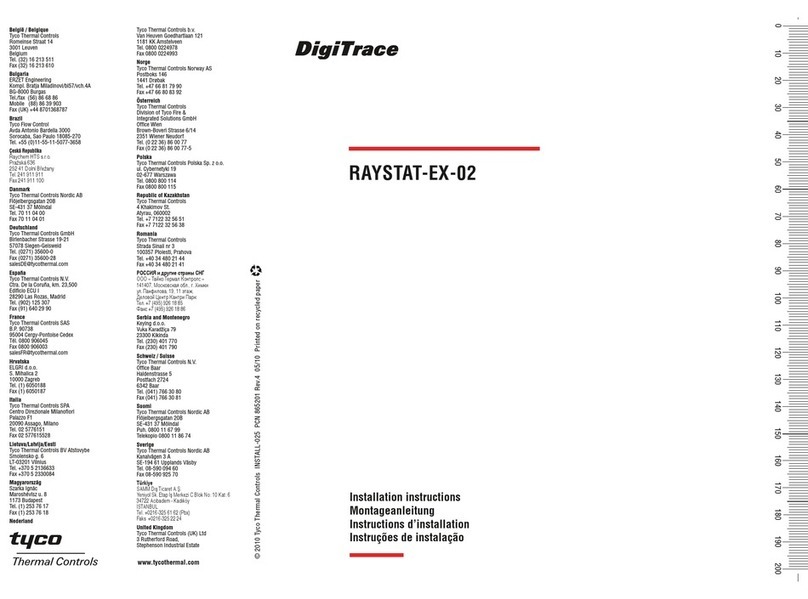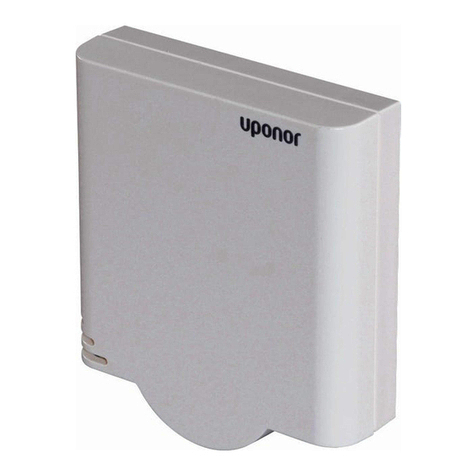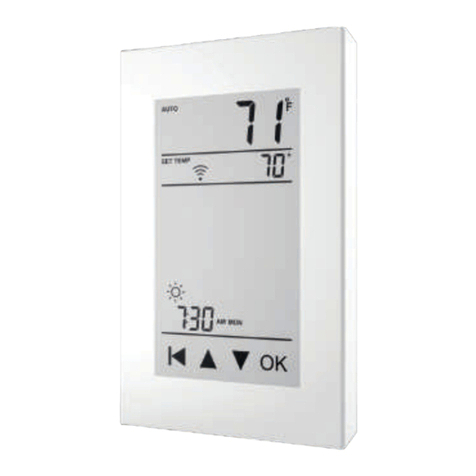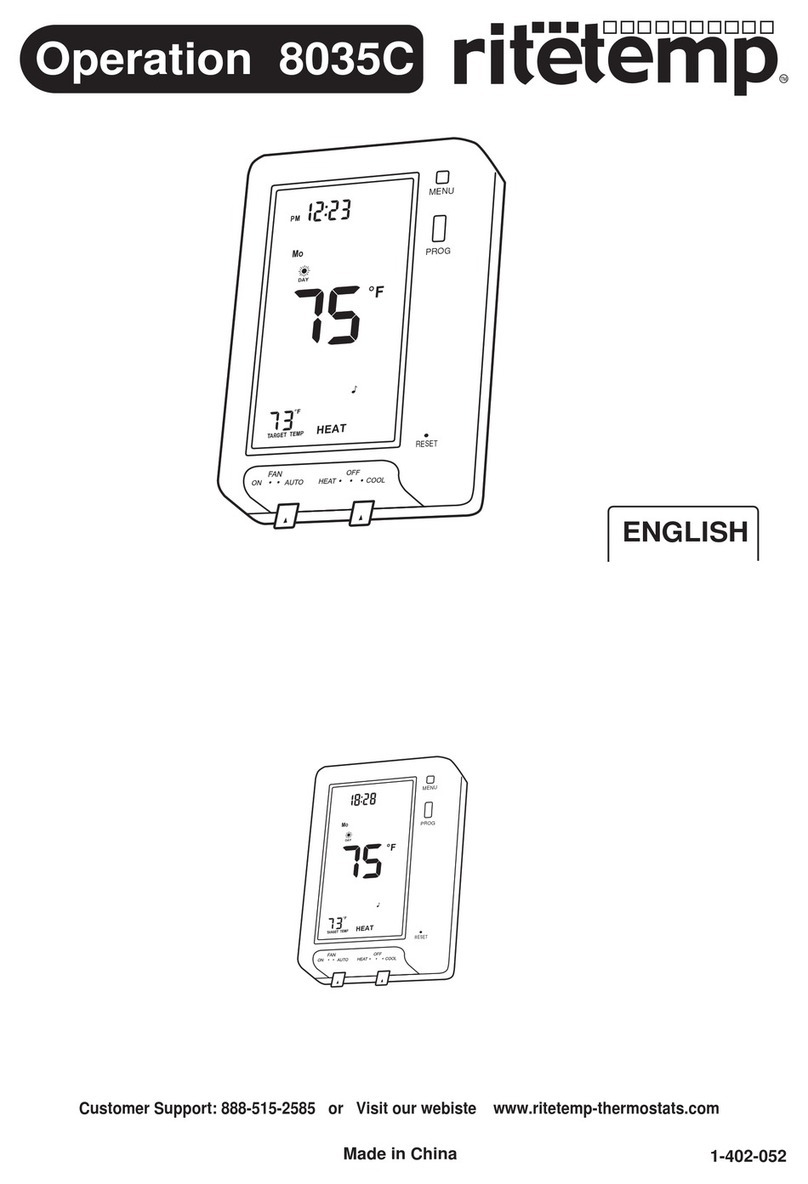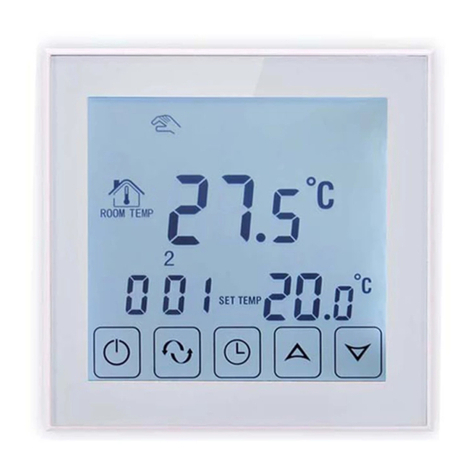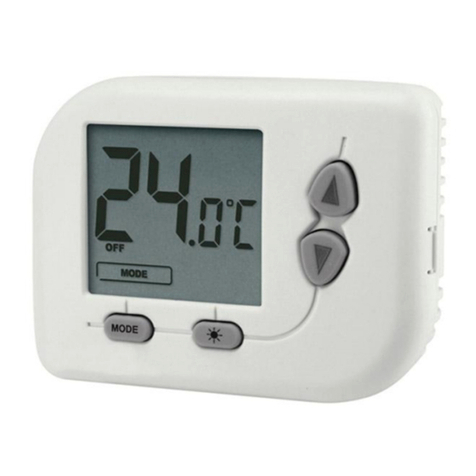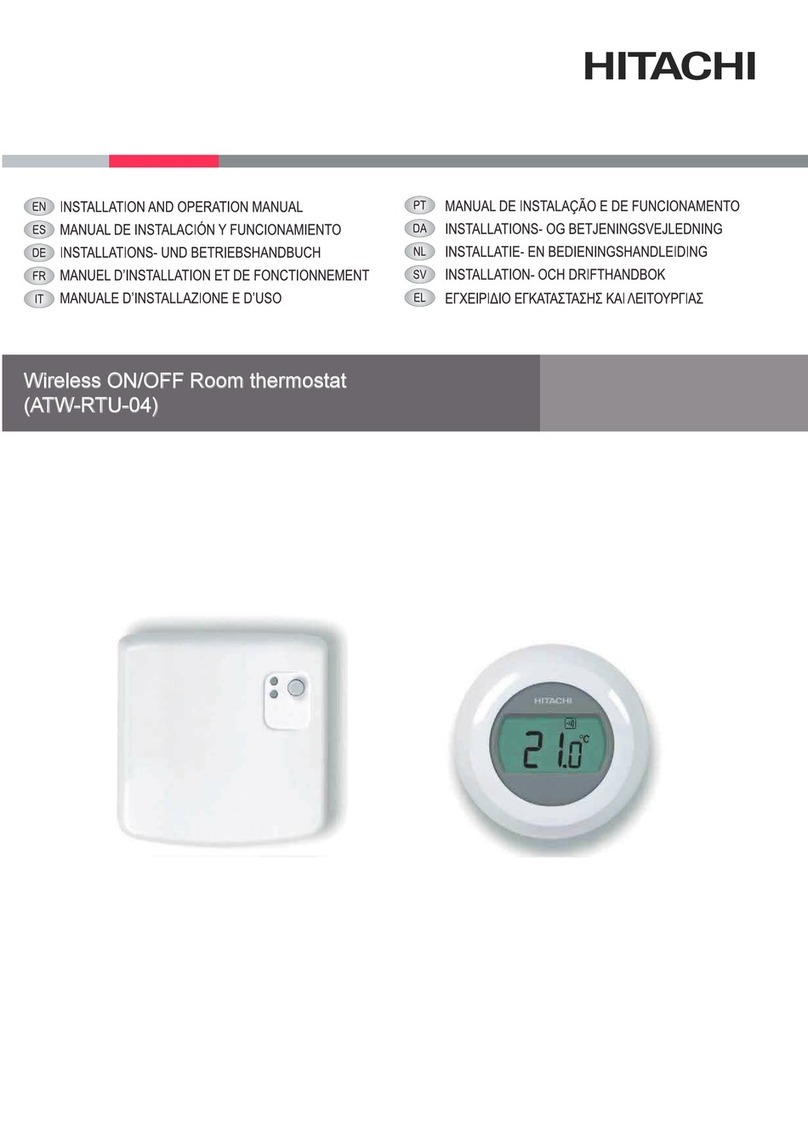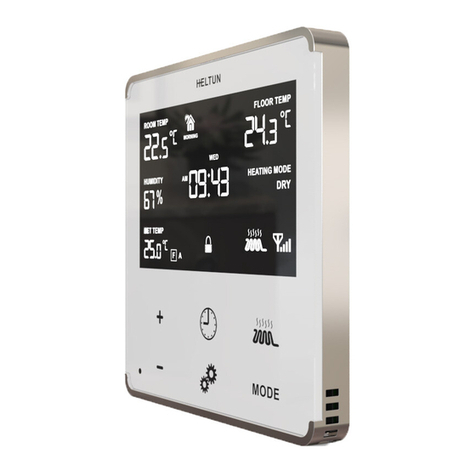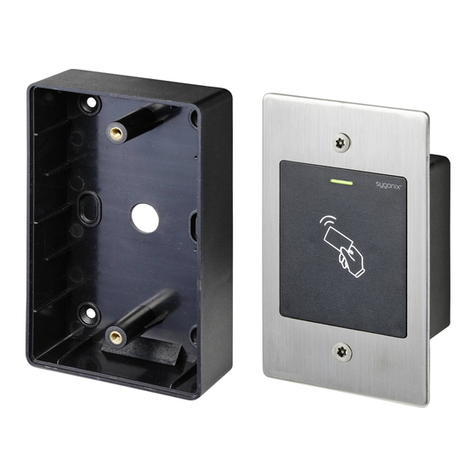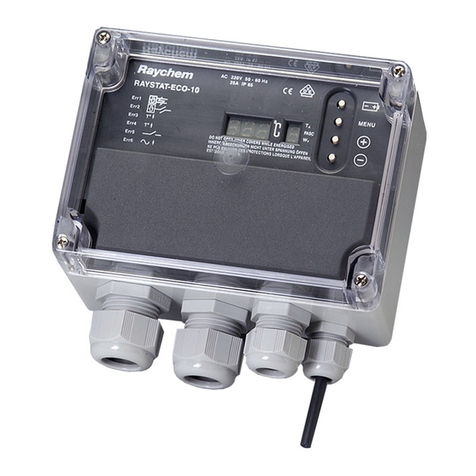Heatit Controls HEATIT Z-TRM3 User guide

1. INTRODUCTION
Heatit Z-TRM3 is an electronic thermostat for electrical floor heating,
designed to be mounted in a standard flush box. The thermostat has
a built-in Z-Wave chip that can be connected with Home Automation
systems. Heatit Z-TRM3 is equipped with a single-pole relay and fits
into System 55 frames. The thermostat can withstand a load of max
16A /3600W at 230V. The thermostat may be used for water based
heating if the thermostat is linked to the Heatit Z-Water.
NB! If the sensor mode is changed to A or AF mode then a room
sensor compensation process will start, which limits maximum power
output to 75%. The thermostat adapts to the environment within a
few days. No internal sensor calibration should be performed during
the first few days.
2. STATEMENT REGARDING PRODUCTS FROM MULTIPLE
MANUFACTURERS
Please read this before installation
This device may be used with all devices certified with the Z-Wave Plus™
certificate and should be compatible with such devices produced by
other manufacturers. Every primary controller is different depending on
the manufacturer, their target consumer and intended use/application.
Please review the functionalities implemented by the primary controller
you intend to use with our Z-Wave Plus certified device to ensure that it
provides the necessary controls to take full advantage of our product’s
capabilities.
3. BEHAVIOR WITHINTHE ZWAVE NETWORK
This device may be operated within any Z-Wave network with
Z-Wave-certified devices from other manufacturers. All non-battery
operated nodes within the network will act as repeaters regardless of
manufacturer to increase the reliability of the network. On delivery, the
device does not belong to any Z-Wave network. The device needs to be
added to an existing network to communicate with the other devices
within it. Devices may also be removed from a network. The add/remove
processes are initiated by the primary controller of the Z-Wave network.
The primary controller has a mode for adding or removing devices.
Please refer to your primary controller manual on how to set the
primary controller in add/remove mode. The device may only be
added or removed from the network if the primary controller is in
add/remove mode.
4. QUICK START
1. Switch off the mains supply (disable the fuse).
2. Open the wall switch box.
3. Connect wires according to the labeling described in
chapter 5 ”Installation”.
4. After verifying the connections, switch the mains supply back on.
5. Set the primary controller in add mode (security/non-security).
6. Press and hold the center button until“OFF”is shown on the
display (approx. 10 seconds).
7. Press down button until you reach“CON”, press and hold until the
display shows a rotating light pattern.
8. The thermostat will display“INC” when the thermostat is
successfully added.
NB! If adding/removing fails, Err (error) will appear.
HEATIT
ZTRM3
Firmware 4.0
Installers manual
Ver 2020-C
TABLE OF CONTENTS
1 Introduction
2 Statement regarding products from multiple manufacturers
3 Behavior within the Z-Wave™ network
4. Quick Start
5. Installation
5.1 Controls
6. Add/Remove
6.1 Method 1 Standard (manual)
6.2 Method 2 SmartStart (automatic)
7 Factory Reset
7.1 Startup
8 Principles of regulation
9 Programming thermostat
10 Temperature shown in display
11 Standby and main screen
12 Choice of sensor
13 Selecting the right Ohm value for your external floor sensor
14 Calibration
15 Brightness
16 Hysteresis (dIF)
17 Min/Max temperature settings
18 Fast functions from Standby / Main Screen
18.1 Display on/off - don/doF
18.2 Childlock - Lock
19 Error codes
20 Z-Wave QR-code / DSK
21 Security
22 Node Information Frame
23 Associations
24 Configuration parameters
25 Command class specifications
Product information
01.03.20

51,1mm
15,6mm
21,3mm
49,5mm
49,5mm
5. INSTALLATION
Installation must be done by a qualified electrician in accordance with
the National Building codes. Before installation, disconnect any power to
the thermostat mains. During installation of the thermostat, power to the
thermostat must be disconnected AT ALL TIMES!
5.1 CONTROLS
Use e.g. a small slotted screwdriver. Start by carefully removing the front
cover by pushing the release springs. The front cover and the frame may
now be removed.
Connect the wires to the thermostat terminals:
Use 1,5mm² or 2,5mm² according to load.
HEATING N Heating cable connection (Neutral)
N Power connection (Neutral) 230V
L Power connection (Live) 230V
HEATING L Heating cable connection
FLOOR SENSOR NTC type (10, 12, 15, 22, 33 or 47kΩ)
Default 10kΩ
EXTERNAL SENSOR NTC type (10, 12, 15, 22, 33 or 47kΩ)
Default 10kΩ
Next, position the thermostat and mount it into the wall flush box
using 2-4 screws. Position the frame over the flush box, then position
and carefully press the front cover until it snaps in place. Check that
the front cover has snapped in place properly on both sides. The front
cover should now fit firmly on all sides. In order to read the Power
Made in EU
16A 230V~
50/60HZ
IP21
TF 058
HEATING L
L
N
HEATING N
FLOOR
SENSOR
EXTERNAL
SENSOR
Z-TRM3
Release spring
58,8mm
87mm
1: Left 2: Center 3: Right
MULTIREG® Z-WAVE
Metering, the load needs to be connected to both heating L + N.
NOTE! The top cover has to be installed when the thermostat is
connected to the main power source. The thermostat is not a SELV
product. All voltage parts must be considered to be 230VAC.
6. ADD/REMOVE
The primary controller/gateway has a mode for adding or removing
devices. Please refer to your primary controller manual on how to set the
primary controller in add/remove mode. The device may only be added
or removed from the network if the primary controller is in add/remove
mode. When the device is removed from the network, it will NOT revert to
factory settings.
There are two ways to add the Heatit Z-TRM3 to a Z-Wave network.
6.1 METHOD 1: STANDARD MANUAL
1. Press Center (confirm) for 10 seconds. The display will show OFF.
2. Press Right (down) 5 times until you see Con on the display.
3. Start the add/remove device process in your primary controller.
4. Start the add/remove mode in the Heatit Z-TRM3 by pressing
Center (confirm) for approximately 2 seconds.
Adding/removing mode is indicated on the display by rotating
LED segments on the display. This lasts until the timeout occurs
after 90 seconds, or until the module has been added/removed
in the network. Confirmation will show Inc/EcL on the display. Exit
programming mode by choosing ESC in the menu. Your thermostat
is now ready for use with default settings.
NB! When the thermostat is removed from the gateway, the
parameters are not reset. To reset the parameters, see Chapter 7:
”Factory reset”. If adding/removing fails, Err (error) will appear.
Please perform a ”remove device”process and try again. If Err displays
again, please see Chapter 7: “Factory reset”.
6.2 METHOD 2: SMARTSTART AUTOMATIC
SmartStart enabled products can be added into a Z-Wave network
by scanning the Z-Wave QR-Code present on the product with a
controller providing SmartStart inclusion. No further action is required
and the SmartStart product will be added automatically within 10
minutes of being switched on in the network vicinity.
The Z-Wave QR-Code locations may be found in Chapter 20
”Z-Wave QR-Code/DSK”.
7. FACTORY RESET
By pressing buttons Right and Center (down and confirm) for 20 seconds,
the thermostat will perform a complete factory reset.
NB! Please use this procedure only when the primary controller/ gateway
is missing or otherwise inoperable.
The device will display rES for 10 seconds while performing a factory reset.
When rES no longer is displayed, the thermostat has been reset.
7.1 STARTUP
AFTER POWERING UP THE THERMOSTAT FOR THE FIRST TIME, ALL
PARAMETERS WILL HAVE DEFAULT SETTINGS.

8. PRINCIPLES OF REGULATION8. PRINCIPLES OF REGULATION
Using Floor / External sensor (F, A2 or A2F-Mode)
The thermostat uses temperature readings retrieved from the internal
sensor or external wired sensor to regulate heating. When you have
chosen a setpoint temperature, the thermostat will use an internal
hysteresis to regulate the temperature. This hysteresis is adjustable.
See Chapter 5“Installation”.
Using Internal sensor (A-mode/AF mode)
If you have a set point of 20°C, the thermostat will use the full power until
the temperature is 19°C. The thermostat will then begin to regulate the
output from 19°C with a 75% duty cycle until it reaches 19,25°C.When
the temperature has reached 19.5°C the thermostat will use a 50% duty
cycle, until it reaches 20°C,then the thermostat turns off and repeats the
process. For example, at a 75% duty cycle it will turn ON for a total of 90
minutes and OFF for 30 minutes.
50% duty cycle
75% duty cycle
20 min.
30 min. 30 min. 30 min.
20 min.
2 hrs.
2 hrs.
20 min.
9. PROGRAMMING THE THERMOSTAT
To activate the programming mode, press Center (confirm) for 10
seconds. The display will show OFF. You are now in programming
mode. To scroll up and down in the menu, use buttons 1 and 3 (left
and right) to navigate. To enter the submenu, press Center (confirm).
Always confirm your setting by pressing Center (confirm) for
2 seconds. Sto will appear to indicate saved settings.
10. TEMPERATURE SHOWN IN DISPLAY
By default, the temperature shown on the display is the setpoint. This may
be altered with parameter 13: “Temperature display”. You may calibrate
the sensor values ±4 degrees using parameters 10 to 12.
11. STANDBY AND MAIN SCREEN
When the thermostat remains untouched for a while, it will automatically
revert to the standby screen. The standby screen will by default show
the setpoint temperature. By pressing any button once, you will see the
measured temperature. By pressing the left or right (up or down) button
one more time, you will change the setpoint.
Menu structure
OFF Turns the thermostat off.
Sensors:
CHOICE OF SENSORS
FDepending on your choice of sensors, the menu
will change.
SEnSelect the right Ohm value for your external/floor sensor.
NTC type (10, 12, 15, 22, 33 or 47kΩ). Default 10kΩ.
CAE Calibration for external sensor.
CAF Calibration for floor sensor.
CAr Calibration for internal sensor.
br1 The display brightness may be adjusted in this menu.
Con Activation of inclusion/exclusion mode.
dIF Hysteresis.
ALoSetting lowest allowed temperature (limitation).
(Air sensor)
AHI Setting highest allowed temperature (limitation).
(Air sensor)
Flo Setting lowest allowed temperature (limitation).
(Floor sensor)
FHI Setting highest allowed temperature (limitation).
(Floor sensor)
A2L Setting lowest allowed temperature (limitation).
(A2 air sensor)
A2H Setting highest allowed temperature (limitation).
(A2 air sensor)
ESC Escape – exit programming menu.
12. CHOICE OF SENSOR
The thermostat has a range of choices when it comes to sensors.
To access the menu, press Center (confirm) for 10 seconds, then press
Right (down) once. An A will appear on the display. Then press Center
(confirm) again and choose modes while moving up and down with
buttons Left or Right:
F Floor sensor
A Internal sensor
AF nternal sensor + Floor sensor
A2 External room sensor
A2F External room sensor + Floor sensor
When you have chosen sensor mode, press the Center (confirm) button.
If you choose F without having a floor sensor connected, Er4 will be
shown in the display. If you choose A2 or A2F and there is no external
sensor installed, Er5 will be displayed on the screen.
NOTE: Wooden floors require that a floor sensor is connected in order
to limit the floor temperature to a maximum of 27°C (in accordance with
specifications from most wooden floor manufacturers).
When using the thermostat is used in (AF or A2F) the floor limiter FHI is
automaticly set to 27°C. When using any other sensor type (A, F or A2F)
the max temperatures is default 5°C minum and 40°C maximum.
13. SELECTING THE RIGHT OHM VALUE FOR YOUR EXTERNAL
FLOOR SENSOR
The following values are available: NTC type (10, 12, 15, 22, 33 or 47kΩ).
Default 10kΩ. Confirm with the Center (confirm) button. You can not
combine two types of NTC sensors.

14. CALIBRATION
(CAr, CAF, CAE – Parameters 10, 11, 12)
Using Floor / External sensor (F, A2 or A2F-mode)
In this mode, you may adjust the displayed temperature. If the
Temperature sensor is not calibrated properly, you can make minor
changes to the temperature readout. You can calibrate the measured
temperature by up to ±4°C.
You may later adjust the temperature recorded by the sensor using in the
menu structure or using parameters.
SENSOR TYPE CALIBRATION FROM
MENU STRUCTURE
PARAMETER
Internal Sensor CAr 10
Floor Sensor CAF 11
External Sensor CAE 12
15. BRIGHTNESS
Use Left and Right (up and down) buttons to adjust the brightness level
from 0 to 9. Confirm with the Center (confirm) button.
16. HYSTERESIS dIF
In this mode, you can make changes to the thermostat hysteresis. You
may change the hysteresis from 0,3°C up to max 3,0°C. Confirm with the
Center (confirm) button. The Default setting is 0,5°C. When using water
based heating, the recommended hysteresis is a minimum of 1,0°C.
This only applies when using a floor sensor or an external sensor.
17. MIN/MAX TEMPERATURE SETTINGS
Flo Min Floor temperature
FHI Max Floor temperature
ALo Min Air/room temperature
AHI Max Air/room temperature
Confirm with Center (confirm)
ESC Leaving programming mode.
Confirm with the Center (confirm) button.
When using the thermostat is used in (AF or A2F) the floor limiter FHI is
automatically set to 27°C. When using any other sensor type (A, F or A2F)
the max temperatures is default 5°C minum and 40°C maximum.
18. FAST FUNCTIONS FROM STANDBY / MAIN SCREEN
This is a list of some functions that you may use without entering the
menu structure. From standby modus you may do the following:
18.1 DISPLAY ON/OFF don/doF
Activate by pressing the Left and Center (up and confirm) buttons for
10 seconds. The display light is temporarily activated if one of the
buttons is pushed.
In case doF is activated, the screen will be blank (may be used if installed
where people are sensitive to the display light). When touching the
display, the screen lights up.
18.2 CHILD LOCK LOC
By pressing the Left and Right (up and down) buttons for 10 seconds,
child lock will be activated, and no changes can be made. Trying to
make changes causes the LOC text to appear on the display.
Child lock is deactivated by pressing Left and Right (up and down)
buttons for 10 seconds. OPn will appear on the display.
19. ERROR CODES
Err Adding fail
See Chapter 6.1 ”Add/Remove”.
Er1 Internal error
Contact your local dealer.
Er2 Z-Wave error
Contact your local dealer.
Er3 Internal error
Contact your local dealer.
Er4 Floor sensor error
You have chosen F, AF or A2F sensor mode without having a
floor sensor connected, or the sensor may be damaged.
Er5 External sensor error
You have chosen A2 or A2F, and there are no external
sensors installed or the sensor may be damaged.
20. ZWAVE QRCODE / DSK
The QR-Code is needed when including a device using S2 security or
SmartStart. The Z-Wave DSK can be found in the QR-Code which is
located in 3 locations:
1. On the product box.
2. On the physical product, placed on the black plastic underneath
the front.
3. On the PCB internally.
21. SECURITY
S2 security enhances Z-Wave Plus with an additional layer of AES 128-bit
encryption of the wireless Z-Wave communication to prevent hacking
and man-in-middle attacks on the home network. This device supports
S2 and has a Z-Wave DSK QR-Code label that may be used when the
module is added to the Z-Wave home network. The primary controller will
ask for a 5-digit code, which can be found underneath the QR-Code.The
primary controller will then ask you to confirm the rest of the code that is
contained in the QR-Code.
22. NODE INFORMATION FRAME
The node information frame is the ”business card”of a Z-Wave device.
It contains information about the device type and its technical features.
The add and remove procedure of the device is confirmed by sending
out a node information frame. Besides this, it may be necessary for certain
network operations to send out a node information frame.
23. ASSOCIATIONS
Z-Wave devices interact with other Z-Wave devices. The relationship
between one device controlling another device is called an association.
In order to control a subordinate device, the controlling device needs to
maintain a list of devices that will receive controlling commands. These
lists are called ”Association Groups”. They are always related to the specific
event triggered (e.g., sensor reports). In case the event is triggered, all
devices stored in the respective association group will receive a joint
wireless command.
SETTING AND REMOVING ASSOCIATIONS
Associations may be assigned and removed via Z-Wave commands.
Please refer to your primary controller/Z-Wave gateway for more
information.

ASSOCIATION GROUPS WITHOUT MULTICHANNEL SUPPORT
When used in a system without Multi Channel support:
THERMOSTAT DEVICE THE MAIN THERMOSTAT DEVICE
Group 1
Lifeline
Lifeline. (Normally used by the Z-Wave Control-
ler) Sends:
- Device Reset Notifications.
- Thermostat Setpoint Reports
- Thermostat Mode Reports
- Thermostat Operating State
- Basic Reports
- Meter Reports
Max. nodes in group: 5
Group 2
State of relay ON/OFF
Send Binary Switch Set commands representing
the status of the internal relay.
Max. nodes in group: 5
Group 3
Internal sensor
Send Multilevel Sensor Reports for internal
temperature sensor.
Max. nodes in group: 5
Group 4
External sensor
Send Multilevel Sensor Reports for external
room temperature sensor.
Max. nodes in group: 5
Group 5
Floor sensor
Send Multilevel Sensor Reports for floor sensor.
Max. nodes in group: 5
24. CONFIGURATION PARAMETERS
Z-Wave products are supposed to work out of the box after inclusion.
Some device configuration may, however, alter the functionality to
better serve user needs or unlock further enhanced features.
Parameter 1, Parameter Size 1. Operation mode
VALUE DESCRIPTION
0Off
1 Heating mode (Default)
Parameter 2, Parameter Size 1. Sensor mode
VALUE DESCRIPTION
0 F-mode, floor sensor mode
1 A-mode, internal room sensor mode (Default)
2 AF-mode, internal room sensor with floor limitation
3 A2-mode, external room sensor mode
4 A2F-mode, external sensor with floor limitation
Parameter 3, Parameter Size 1. Floor sensor type
VALUE DESCRIPTION
0 10K NTC (Default)
1 12K NTC
2 15K NTC
3 22K NTC
4 33K NTC
5 47K NTC
Parameter 4, Parameter Size 1. Temperature control hysteresis (diF)
VALUE DESCRIPTION
3 to 30 0.3°C to 3.0°C. Default is 5 (0.5°C)
Parameter 5, Parameter Size 2. Floor minimum temperature limit (Flo)
VALUE DESCRIPTION
50 to 400 5.0°C to 40.0°C. Default is 50 (5.0°C)
MULTICHANNEL SUPPORT
Heatit Z-TRM3 has support for the Multichannel Command Class. This
allows the thermostat to be perceived as many devices by the primary
controller, where each of the devices has association groups in order to
send information to other Z-Wave devices. See the chapter concerning
”Association Groups”for more information. Commands sent to each
logical device will be interpreted according to the description in the
section ”Supporting Command Classes”.
NO MULTICHANNEL SUPPORT
If the primary controller or the Z-Wave devices to be associated with
Heatit Z-TRM3 do not support the Multichannel Command Class
(Multichannel encapsulation), only the association groups in the root
device are accessible. This device contains 5 association groups.
See Chapter 23 concerning ”Association Groups”for more information.
The root device is the actual thermostat device.
ASSOCIATION GROUPS WITH MULTICHANNEL SUPPORT
When used in a system with Multichannel support:
THERMOSTAT DEVICE 1 THE MAIN THERMOSTAT DEVICE
Group 1
Group 2
Lifeline. (Normally used by the Z-Wave Control-
ler) Sends:
-Thermostat Setpoint Reports
-Thermostat Mode Reports
-Thermostat Operating State
-Meter Reports
Max. nodes in group: 5
Send Binary Switch Set commands representing
the status of the internal relay.
Max. nodes in group: 5
MULTILEVEL SENSOR
DEVICE 2
DEVICE FOR INTERNAL ROOM
TEMPERATURE SENSOR
Group 1
Group 2
Lifeline
Send Multilevel Sensor Reports.
Max. nodes in group: 5
Send Multilevel Sensor Reports.
Max. nodes in group: 5
MULTILEVEL SENSOR
DEVICE 3
DEVICE FOR EXTERNAL ROOM
TEMPERATURE SENSOR
Group 1
Group 2
Lifeline
Send Multilevel Sensor Reports.
Max. nodes in group: 5
Send Multilevel Sensor Reports.
Max. nodes in group: 5
MULTILEVEL SENSOR
DEVICE 4
DEVICE FOR FLOOR SENSOR
Group 1
Group 2
Lifeline
Send Multilevel Sensor Reports.
Max. nodes in group: 5
Send Multilevel Sensor Reports.
Max. nodes in group: 5

Parameter 6, Parameter Size 2. Floor maximum temperature limit (FHi)
VALUE DESCRIPTION
50 to 400 5.0°C to 40.0°C. Default is 400 (40.0°C)
Parameter 7, Parameter Size 2. Air (A2) minimum temperature limit (ALo)
VALUE DESCRIPTION
50 to 400 5.0°C to 40.0°C. Default is 50 (5.0°C)
Parameter 8, Parameter Size 2. Air (A2) maximum temperature limit (AHi)
VALUE DESCRIPTION
50 to 400 5.0°C to 40.0°C. Default is 400 (40.0°C)
Parameter 9, Parameter Size 2. Heating mode setpoint
VALUE DESCRIPTION
50 to 400 5.0°C to 40.0°C. Default is 210 (21.0°C)
Parameter 10, Parameter Size 1. Room sensor calibration (A)
NB. To set a negative value, use 256 and subtract the desired value.
VALUE DESCRIPTION
-60 to 60 -6.0°C to 6.0°C. Default is 0 (0.0°C)
Parameter 11, Parameter Size 1. Floor sensor calibration
NB. To set a negative value, use 256 and subtract the desired value.
VALUE DESCRIPTION
-60 to 60 -6.0°C to 6.0°C. Default is 0 (0.0°C)
Parameter 12, Parameter Size 1. External sensor calibration
NB. To set a negative value, use 256 and subtract the desired value.
VALUE DESCRIPTION
-60 to 60 -6.0°C to 6.0°C. Default is 0 (0.0°C)
Parameter 13, Parameter Size 1. Temperature display
Selects which temperature is shown on the display.
Refer to Chapter 11 ”Standby and main screen”.
VALUE DESCRIPTION
0 Display setpoint temperature (Default)
1 Display measured temperature
Parameter 14, Parameter Size 1. Button brightness – dimmed state
Configure the brightness of the buttons in dimmed state.
VALUE DESCRIPTION
0 to 100 0 to 100% (Default 50%)
Parameter 15, Parameter Size 1. Button brightness – active state
Configure the brightness of the buttons in active state
VALUE DESCRIPTION
0 to 100 0 to 100% (Default 100%)
Parameter 16, Parameter Size 1. Display brightness – dimmed state
Configure the brightness of the display in dimmed state.
VALUE DESCRIPTION
0 to 100 0 to 100% (Default 50%)
Parameter 17, Parameter Size 1. Display brightness – active state
Configure the brightness of the display, in active state.
VALUE DESCRIPTION
0 to 100 0 to 100% (Default 100%)
Parameter 18, Parameter Size 2. Temperature report interval
Time interval between consecutive temperature reports.
Temperature reports can also be sent as a result of polling.
VALUE DESCRIPTION
30 to 32767 30 seconds to 32767 seconds. Default is 60 seconds
Parameter 19, Parameter Size 1. Temperature report hysteresis
The temperature report will be sent if there is a difference in temperature value
from the previous value reported, defined in this parameter (hysteresis).
Temperature reports can also be sent as a result of polling.
VALUE DESCRIPTION
1 to 100 0.1°C to 10.0°C. Default is 10 (1.0°C)
Parameter 20, Parameter Size 2. Meter report interval
Time interval between consecutive meter reports.
Meter reports can also be sent as a result of polling.
VALUE DESCRIPTION
30 to 32767 30 seconds to 32767 seconds. Default is 90 seconds
Parameter 21, Parameter Size 1. Meter report delta value
Delta value in kWh between consecutive meter reports.
Meter reports can also be sent as a result of polling.
VALUE DESCRIPTION
0 Reporting meter based on change is disabled
0 to 255 A delta value of 0 to 25.5 kWh will result in a
metering report. Default is 10 (1.0 kWh)
25. COMMAND CLASS SPECIFICATIONS
SUPPORTED COMMAND CLASSES
The following table lists all Command Classes supported by the Z-Wave
device. The device supports both S0, S2 Authenticated security and
S2 Unauthenticated security.
INSECURE
INCLUSION
INSECURE
ON
SECURE
INCLUSION
SECURE
ON
SECURE
INCLUSION
Z-Wave Plus Information v2 Yes Yes
Association v2 Yes Yes
Association Group Information v1 Yes Yes
Multilevel Sensor v5 Yes Yes
Multichannel Association v3 Yes Yes
Multichannel v4 Yes Yes
Transport Service v2 Yes Yes
Version v3 Yes Yes
Manufacturer Specific v2 Yes Yes
Device Reset Locally v1 Yes Yes
Powerlevel v1 Yes Yes
Security v1 Yes Yes
Security 2 v1 Yes Yes
Supervision v1 Yes Yes
Configuration v3 Yes Yes
Firmware Update v5 Yes Yes

INSECURE
INCLUSION
INSECURE
ON
SECURE
INCLUSION
SECURE
ON
SECURE
INCLUSION
Thermostat Setpoint v3 Yes Yes
Thermostat Mode v3 Yes Yes
Thermostat Operating State v1 Yes Yes
Basic v2 Yes Yes
Meter v3 Yes Yes
SUPPORTED COMMAND CLASSES
Besides the mandatory command classes, Heatit Z-TRM3 has support for
the following command classes:
Basic Command Class
A Basic command to the root endpoint or endpoint 1 will change the
Thermostat Mode. Uses the following values:
0x00 = OFF (thermostat regulation is deactivated)
0x01 = Heating Mode (thermostat regulation is active)
Binary Switch Command Class
Sends Binary Switch commands to other devices when the internal relay
is switched. It used to control other slave relay devices. Uses the following
values:
0x00 = OFF
0xFF = ON
Thermostat Setpoint Command Class
When a Thermostat Setpoint Set command is received by the root device,
it sets the chosen setpoint for heating mode.
Thermostat Mode
It is possible to change the operating mode of the thermostat by sending
a Thermostat Mode Set command. The accessible operating modes are:
0x00 = OFF (thermostat regulation is deactivated)
0x01= Heating Mode (thermostat regulation is active)
Thermostat Operating State
The thermostat reports the operating state of the internal relay using this
command class.
0x00 = Idle (relay is turned OFF)
0x01= Heating (relay is turned ON)
Meter Command Class
The thermostat supports Meter Command Class Get, and the thermostat
will only respond on supported electric meter scales: kWh (accumulated),
Watt (instant) and Volt (instant). The thermostat will report when asked:
Rate import:Import (0x01)
Meter type: Electric meter (0x01)
Precision: 1 decimal (0x01)
PRECISION VALUE SCALE SUPPORTED VALUE SIZE
1 decimal (0x01) kWh (0x01) 4
2 decimals (0x01) W (0x02) 4
1 decimal V (0x04) 2
THERMOSTAT DEVICE 1
Supported Command Classes Association (version 2)
Z-Wave Plus Information (version 2)
Association (version 2)
Association Group Information (version 3)
Multichannel Association (version 3)
Supervision (version 1)
Security (version 1)
Security 2 (version 1)
Thermostat Setpoint (version 3)
Thermostat Mode (version 3)
Thermostat Operating State (version 1)
Controlled Command Classes
Switch Binary (version 1)
Meter (version 3)
MULTILEVEL SENSOR DEVICE 2
Supported Command Classes
Z-Wave Plus Information (version 2)
Association (version 2)
Association Group Information (version 3)
Multichannel Association (version 3)
Supervision (version 1)
Security (version 1)
Security 2 (version 1)
Multilevel Sensor (version 5)
Controlled Command Classes
Multilevel Sensor (version 5)
MULTILEVEL SENSOR DEVICE 3
Supported Command Classes
Z-Wave Plus Information (version 2)
Association (version 2)
Association Group Information (version 3)
Multichannel Association (version 3)
Supervision (version 1)
Security (version 1)
Security 2 (version 1)
Multilevel Sensor (version 5)
Controlled Command Classes
Multilevel Sensor (version 5)
MULTILEVEL SENSOR DEVICE 4
Supported Command Classes
Z-Wave Plus Information (version 2)
Association (version 2)
Association Group Information (version 3)
Multichannel Association (version 3)
Supervision (version 1)
Security (version 1)
Security 2 (version 1)
Multilevel Sensor (version 5)
Controlled Command Classes
Multilevel Sensor (version 5)

PRODUCT INFO HEATIT ZTRM3
FUNCTIONS
• Floor sensor
• Internal room sensor
• External room sensor
(connected by cable)
• Temperature limiter
• SmartStart
• Weekly program/
setback via gateway
• Temperature read out in gateway
• Firmware update (OTA)
• Power metering
• Relay status LED
• Single pole switch
• Lock mode/child lock
• Calibration
• 5 associations
• Supports encryption mode: S0, S2 Authenticated Class,
S2 Unauthenticated Class
This product is a security-enabled Z-Wave Plus product with
encryption. The product must be used with a security-enabled
Z-Wave Controller in order to fully utilize the product.
TECHNICAL DATA
Protocol Z-Wave - 868,4MHz
Chip Z-Wave 500 chip
Rated voltage 230V 50/60Hz
Max load 3600W (resistive load)
750W self-limiting heating cable
Max current 16A
Power consumption <2,0W
Ambient temperature 0°C to 40°C (during operation)
Temperature range 5°C to 40°C
Hysteresis 0,3°C to 3,0°C (default 0,5°C)
Compatible with NTC
sensors with values 10, 12, 15, 22, 33 and 47 kΩ @ 25°C
IP Code IP 21
Approvals Z-Wave Plus, CE, EN 60730-1,
EN 60730-2-9, EMC 2014/30EU,
RoHS 2011/65/EU, LVD 2014/35/EU
Approved for use in bathrooms.
TERMINAL
Use 1,5mm² or 2,5mm² according to load.
MAINTENANCE
The product is maintenance-free, but must not be covered.
ART. NO. PRODUCT COLOR ZWAVE
FREQUENCY
54 305 99 Heatit Z-TRM3 thermostat 3600W 16A White RAL 9003 EU 868,4MHz
54 305 98 Heatit Z-TRM3 thermostat 3600W 16A Black RAL 9011 EU 868,4MHz
54 304 46 Plastic kit for Heatit (front and frame) Black RAL 9011
99 305 60 Heatit Z-TRM3 thermostat 3600W 16A White RAL 9003 RU 869,0MHz
99 305 51 Heatit Z-TRM3 thermostat 3600W 16A White RAL 9003 AUS 921,4MHz
Heatit Controls AB l Läkarvägen 4, 454 31 BRASTAD, SWEDEN
Heatit Controls AB can
not be held liable for
typographical errors, other
errors or omittances in
our information.
Product specifications
may change without
further notice.
All electrical installations
must be carried out by a
licensed electrician.
The product must be installed
in accordance with national
building codes and our
installers manual.
SMARTSTART
This manual suits for next models
1
Table of contents
Other Heatit Controls Thermostat manuals
